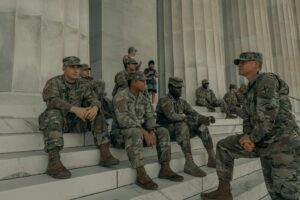
Passports, Power, and Identity: The Supreme Court’s Latest Blow to Transgender Rights:
Overview:
On November 6, 2025, the Supreme Court granted a stay, thus allowing the Department of State to continue to enforce a policy requiring all new U.S. passports to list the sex assigned at birth rather than a gender‐identity marker or an “X” designation.
The policy reversed 33 years of previous practice which allowed applicants to select gender markers consistent with their identity.
A lower federal court had preliminarily enjoined the new policy, finding potential irreparable harm to transgender, nonbinary, and intersex individuals (a position supported by the three Justices who dissented from the stay decision); the Supreme Court’s stay suspends that injunction while the underlying litigation continues.
In short: the Court’s action does not dispose of the merits, but it immediately permits the government’s policy to be enforced while appeals proceed—raising significant legal and practical implications for identity recognition and travel. Notably, the Court’s opinion also indicated its preliminary view that the Government is likely to succeed in the case.
Effect on Military Service Members and Federal Employees
From a legal vantage point, this opinion is about much more than a technical change in the content of travel documents, it constitutes a meaningful shift in how identity, service, and federal recognition intersect for service members and federal employees who are transgender or nonbinary.
At its core, the policy change presents three principal categories of legal concern: (1) mobility and assignment risk; (2) documentary alignment and clearance/fitness burdens; and (3) the doctrinal posture of transgender rights under equal protection and administrative law.
Mobility and Assignment Risk
For a service member or federal employee, passports are not mere travel credentials, they can be mission-essential equipment. When a member’s official identity document reflects a gender marker inconsistent with their lived identity, the risk is operational: at foreign borders, in allied nation environments, on joint exercises, and during global deployments. A passport listing only the sex assigned at birth may immediately out a transgender or nonbinary individual, raising questions of security, host-nation reception, and force protection. The Court’s stay thus has the practical effect of making some assignments riskier for those individuals, even if their other credentials (military ID, DEERS, CAC, etc.) align with their gender identity.
Documentary Alignment and Federal Service Burden
The military and federal employment systems rely on coherence and consistency among personnel records, security clearances, travel documents, medical records, and identity verification systems. When a passport marker diverges from other records, it introduces friction: clearance adjudicators may wonder whether mismatched documents signal concealment or instability. Commanders may hesitate to send qualified individuals into roles where identity mismatches could degrade trust. Transgender and nonbinary persons, therefore, face a unique documentary burden: while their performance may meet standards, their identity alignment becomes a persistent administrative stressor.
Additionally, the policy sends a signal: even if the individual has changed their name, corrected records, and deployed without incident, the federal government now says that their passport will reflect their birth-sex, not their gender identity. That structural disjunction, between recognition in uniform and misrecognition in travel documents, raises novel career and administrative risks.
Doctrinal Posture: Equal Protection & Administrative Law
Legally, Trump v. Orr is important for how it frames transgender/nonbinary rights. In the district-court litigation underlying the stay (Orr v. Trump), the plaintiffs challenged the policy under the Fifth Amendment’s Equal Protection component, the Due Process right to travel, and the Administrative Procedure Act (APA) for arbitrary and capricious agency action. The government argued that listing sex at birth is a factual administrative classification and thus subject only to rational-basis review. The Supreme Court’s decision to allow the stay suggests that at least on the emergency docket it viewed the government’s interest in uniformity of government issuance and foreign-affairs deference as meriting temporary relief.
For military and federal employees, the doctrinal import is this: if the Court treats this kind of identity regulation as subject only to rational-basis review, then future policies impacting transgender and nonbinary individuals, whether in fitness standards, deployment eligibility, health care access, or records changes, may face a less rigorous judicial review threshold. The bureaucratic authority to define which identities count may grow larger.
Specific Implications for Service Members and Federal Employees
- Service members with deployments, TDYs, or exchange billets abroad may now face additional barriers if their passport mis-identifies them. Commands may delay or cancel assignments citing “logistical or diplomatic risk.”
- Noncommissioned and commissioned personnel seeking security clearances could face increased scrutiny if their records show inconsistencies between their identity and travel documentation—creating an unspoken impediment to advancement.
- Veterans transitioning to federal civilian employment or contractor roles may see their mobility and international travel constrained, and their identity-related documentation mismatches may reduce eligibility for roles that require international travel or clearance.
- The ruling signals to federal agencies that policies prerequisite to identity recognition (e.g., gender marker changes, name changes, affirming health care) may be vulnerable to future roll-backs or reinterpretations, complicating long-term planning for transgender and nonbinary federal employees.
Conclusion
While the stay in Trump v. Orr is temporary and the litigation remains ongoing, the immediate outcome is clear: the federal government will now issue passports that ignore gender identity in favor of sex assigned at birth. For transgender and nonbinary individuals in uniform or federal service, this decision shifts mobility from a right to a potential vulnerability, imposes administrative burdens, and signals that identity recognition by the state can be unilaterally narrowed. From a policy-defense standpoint, any advocacy for trans and nonbinary service members must now treat passports and travel documents as frontline rights, not peripheral concerns.
Key Legal Resources & References
- Supreme Court Trump Passport Gender Ruling Washington Post
- Orr v. Trump, Case No. 1:25-cv-10313 (D. Mass.). Case Law
- Trump v. Orr, Application 25A319, Supreme Court. Supreme Court
- Executive Order 14168, “Defending Women from Gender Ideology Extremism and Restoring Biological Truth to the Federal Government.” Whitehouse.gov
- ACLU Press Release, “Supreme Court Allows Trump Administration to Enforce Discriminatory Passport Policy.” American Civil Liberties Union
- Lambda Legal, “Identity Document Guidance for Transgender, Nonbinary, Gender-Nonconforming + Intersex People.” Lambda Legal








